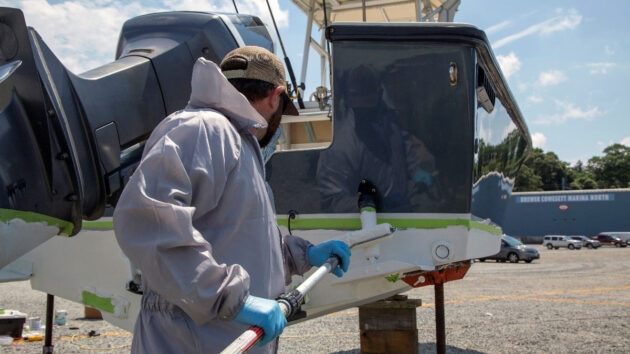AkzoNobel’s International® brand shares expert tips for getting your boat ready for the water this season
Spring Maintenance
Look after the boat, and it’ll look after you. After a winter ashore, there are some spring tasks to schedule before your boat ‘swims’ once more.
It’s a matter of following the three ‘P’s: Preparation, Priming and Protection.
Spring maintenance will always go more smoothly when your vessel is already clean and tidy.
A lack of commitment to seasonal upkeep can even lead in some circumstances to invalidations of insurance policies.
Understanding the crucial importance of spring boat maintenance is vital for achieving peak performance both above and below the waterline.
Spring is the optimum time to rejuvenate your boat.
Preparation
An initial spring clean is recommended, with a thorough cleansing with International® Super Cleaner. This will sweep off all those salt smears as well as dirt and general grime.
The next stage is to look below the waterline on the hull.
Blisters that may weep a fluid resembling vinegar are osmosis: they require treatment.
Examine the keel and rudder for impact damage, cracks, or where the coating may have become loose.
Should remedial action be needed, select the most appropriate tool for the task of grinding out.
Address the affected areas thoroughly. A proper job here will save time later.
Fully dried out areas after treatment will help you get a great finish.
Visual inspection of the interior is a good idea. For this, ensure proper ventilation in lockers and bilges by opening them up.
A deep clean will almost certainly involve lifting the sole boards (in most cases taking them off the boat completely). Everything has to be left to dry properly.
Time taken over this will allow, for example, paint to have a better grip, and therefore increase the life expectancy of your resulting paint job.
As regards the deck, it’s a case of going over any woodwork with care to determine which surfaces should remain untreated, such as teak decking, and which ones require a refresh, whether that be by varnishing or sealing.
Non-slip deck areas ought to get a good scrub-down.

Priming
Should you have identified any cracks or crazing in the gelcoat or paint, then preparatory work is required.
If the gelcoat appears dull or chalky, consider buffing, polishing, or repainting to bring back the shine.
Should any coatings in the bilges and lockers be found to be worn or damaged, take the time to clean and repaint these areas to restore their condition.
Non-slip deck areas will have their durability increased significantly with an application of two coats of Interdeck®.
If you are in doubt about how best to proceed, it is better to seek advice first.
Our advisers are on hand to help you select the most appropriate solutions for hull protection and fouling control.
Factors in this calculation include the quality and condition of the boat.
Evaluate the existing fouling control system; if you notice any peeling paint or excessive buildup, it may be time to remove it.
Select the appropriate fouling control paint that aligns with the specific conditions of your location and the type of boat you have.
When changing brands of fouling control products, consult compatibility charts to confirm that the new paint will adhere correctly.
Primocon® serves as a vinyl-based primer that can be applied over most pre-existing coatings.
Before applying a new fouling control paint, make sure to sand and prepare the surface.
As you will be working underneath the vessel do ensure that you and other maintenance crew are not exposed to any danger.
Protecting your auxiliary propulsion makes common sense: make sure to apply fouling control to your propeller.
Propeller Primer is a fast-drying, single-component primer that boasts outstanding adhesion. This is owing to its Dual-Activated Bonding Technology.
The key attribute is a unified, cohesive coating system.
When used alongside our suggested fouling control, it is designed to withstand dynamic and cavitation forces.
This will safeguard propellers and underwater metals (such as those in transducers and rudder fittings) from the accumulation of fouling. This primer dries quickly and bonds well.
By integrating Propeller Primer with our recommended fouling control solution, you enhance the durability and performance of your propeller, keeping unwanted growth away.
Investing in this combination will help maintain the efficiency of your propeller and prolong the life of your underwater metals.
With the right preparation and products, you can prevent fouling buildup and ensure optimal performance in the water.
Marine life will often be said to select the easiest path to make itself at home on your hull.
But conversely the simplest combination of elements in a defensive system is often the easiest and most effective way to repel that unwanted organic matter.

Protection
Your boat’s topsides deserve protection as well! The One UP and Toplac® Plus two-step system from International® offers several advantages.
Firstly, it allows for quicker application, requiring fewer coats to achieve a professional look.
Secondly, it offers superior UV protection, which helps preserve both colour and gloss over time.
The sun’s harmful rays degrade the boat’s skin, in a manner of speaking, so that the shade of paint that originally graced the hull’s topsides may have faded or even become blotchy in places with the passage of time.
The most enamelled-looking solid colours or finishes can, owing to the power of the sun’s light, dim or wash out to the more ‘matt emulsion’ effect.
Lastly, it delivers a smoother and glossier finish, eliminating the need for brush tipping.
To lengthen your boat’s lifespan, boost performance, and enjoy a hassle-free season on the water, check out our full 2025 Boat Painting Guide
Have questions about boat maintenance, coatings, or product recommendations? Our team of experts is ready to assist you in choosing the best solutions for your boat.




